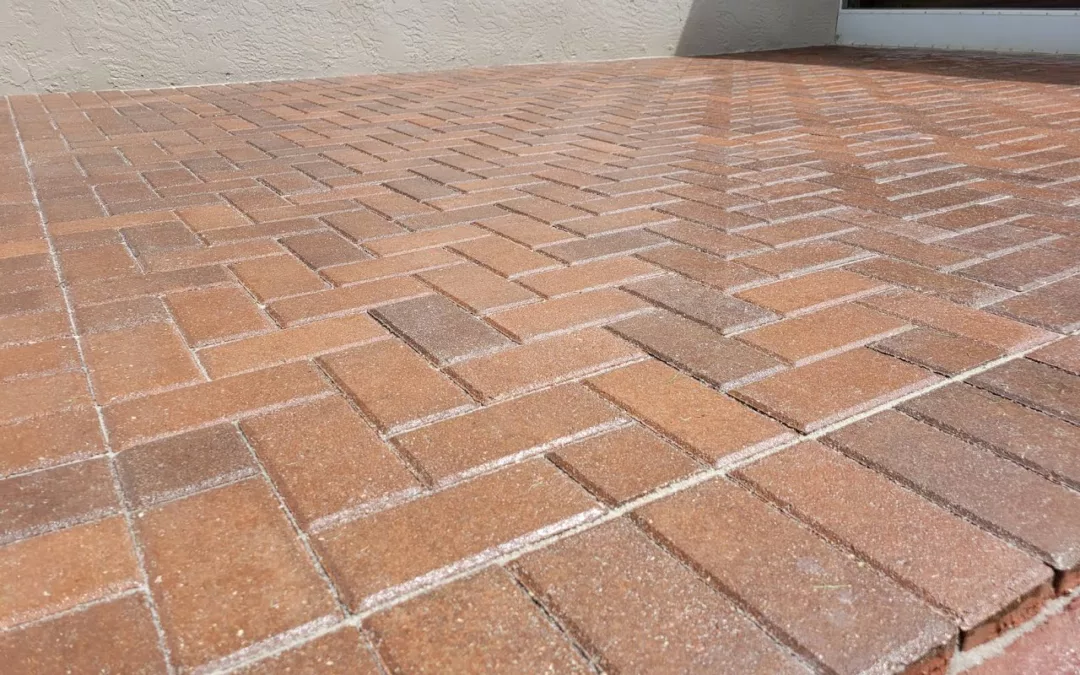Paver sealing is an essential process that can help protect the surface of your pavers from damage, enhance their appearance, and extend their lifespan. However, to achieve optimal results, it’s crucial to understand what paver sealing entails and how to do it correctly.
The first step in paver sealing is proper preparation. This involves thoroughly cleaning the surface of your pavers, removing any stains or debris, and allowing them to dry completely before applying the sealant. Failure to prepare the surface properly can result in poor adhesion and a subpar finish.
The type of paver surface will also determine the appropriate product and application method needed for optimal results. For instance, porous surfaces such as concrete require a different sealant than non-porous surfaces like brick or stone.
Paver sealing provides numerous benefits beyond just enhancing appearance. It protects against UV rays, water damage, stains, weed growth, and enhances color retention. The application process typically involves using a sprayer with a v4 nozzle to evenly distribute the sealant over the entire surface of your pavers.
For more information on best practices for paver sealing or if you need assistance with this task, consult with an industry professional or refer to reputable online resources like Paver Sealing Parser. By following these guidelines and taking care during each step of the process, you can ensure that your pavers are protected for years to come.
How to Seal and Maintain Concrete Interlocking Pavers and Bricks
Clean the Surface
Before sealing your interlocking pavers or bricks, it is crucial to clean them thoroughly. Removing any debris, dirt, or stains will ensure that the sealer adheres properly to the surface. A pressure washer or a stiff-bristled brush can be used for cleaning. If there are any stubborn stains, use a specialized cleaner designed for interlocking pavers.
After cleaning, allow the surface to dry completely before proceeding with sealing. Any moisture on the surface can prevent proper adhesion of the sealer and cause it to peel off.
Apply Silica Sand
Applying sand is an essential component in maintaining interlocking pavers or bricks. It helps prevent weed growth and keeps the pavers in place by filling in the joints between them.
To apply Silica sand, pour it onto the surface of the pavers and sweep it into the joints using a broom. Make sure to fill all gaps completely and remove any excess sand from the surface before proceeding with sealing. Now that you have filled the gaps between the pavers with sand, it’s time to seal them!
Choose The Right Sealer
Choosing the right sealer for your specific type of interlocking pavers or bricks is crucial for achieving optimal results. There are different types of sealers available in the market such as water-based, solvent-based, and acrylic-based sealers.
Water-based sealers are eco-friendly and easy to apply but may not provide long-lasting protection against harsh weather conditions. Solvent-based sealers offer better protection against UV rays and harsh weather but require more time for drying and emit harmful fumes during application. Acrylic-based sealers offer excellent protection against UV rays and harsh weather conditions while also being easy to apply.
It’s important to choose a sealer that suits your needs based on factors such as durability requirements, environmental concerns, budget constraints, etc.
Apply Sealer Evenly
Once you have chosen your sealer type, make sure to apply it evenly on all surfaces of interlocking pavers or bricks. Use a roller or sprayer to apply the sealer and avoid overlapping areas.
Cover all areas of the surface, including edges and corners, to ensure complete protection against weather conditions. Overlapping can cause uneven application and may lead to peeling off of the sealer.
Maintain Regularly
Sealing is not a one-time process. You need to maintain it regularly by cleaning the surface and reapplying sealer every few years. This will help prolong the life of your interlocking pavers or bricks and keep them looking new for longer.
Regular maintenance includes cleaning any debris, dirt, or stains that accumulate on the surface using a pressure washer or a stiff-bristled brush. If there are any stubborn stains, use specialized cleaners designed for interlocking pavers.
Reapply sealer every few years to ensure continued protection against harsh weather conditions. The frequency of reapplication depends on factors such as climate, usage, and type of sealer used.
Sealing Concrete Pavers: The How, Why, and What to Consider
Choosing the right type of sealant is crucial to ensure that it works effectively with your specific type of concrete pavers. Sealing pavers is an essential step in maintaining the longevity and appearance of your concrete pavers. Forming sealants create a protective film on the surface of the concrete, preventing water and other elements from penetrating the surface and causing damage.
When considering sealing your concrete pavers, weighing the options and keeping the type of joint in mind can help you make an informed decision. Joint sand and polymetric sand can help prevent shifting in some cases, but it’s important to keep in mind that joint sand may need to be replaced periodically. A professional contractor can save you time and ensure that the job is done correctly.
The first thing to consider when sealing your concrete pavers is choosing the right type of sealant for your project. There are various types of sealants available on the market, including water-based, solvent-based, acrylics, urethanes, epoxies, etc. Each has its own set of advantages and disadvantages depending on factors such as climate conditions or traffic volume.
Water-based sealers are popular because they are environmentally friendly and easy to apply. They also dry quickly which means you can walk on them within hours after application. Solvent-based sealers are oil-based products that provide excellent protection against water penetration but require more time to dry than water-based products.
Acrylic sealers offer good protection against UV rays while still allowing moisture vapor transmission through pores in the sealer film. Urethane coatings provide excellent abrasion resistance making them ideal for high-traffic areas like driveways or patios.
Epoxy coatings provide superior adhesion making them ideal for use on garage floors or other surfaces subject to heavy wear-and-tear. However, epoxy coatings tend to yellow over time when exposed to sunlight so they may not be suitable for outdoor use.
Once you have chosen a sealant, the next step is to prepare the surface of your concrete pavers. The surface should be clean and free of any debris or stains. Any cracks or holes in the surface should be filled with a suitable filler before applying the sealant.
A professional contractor can ensure that the job is done correctly by using specialized equipment such as pressure washers or grinders to prepare the surface. They also have experience working with different types of sealants and can advise you on which type would work best for your specific project.
There are two main options: regular joint sand and polymetric sand. Regular joint sand is made from fine particles of crushed stone and is used to fill gaps between pavers. It helps prevent shifting but may need to be replaced periodically.
Polymetric sand is a mixture of fine sands and polymer additives that harden when exposed to moisture. This makes it ideal for use in high-traffic areas like driveways or patios where shifting is more likely to occur.
How Often Should Pavers be Sealed? A Comprehensive Guide
Maintaining the appearance and durability of pavers is crucial to ensuring their longevity. One of the most effective ways to protect pavers from damage caused by weather and foot traffic is through regular sealing. But how often should pavers be sealed? In this section, we will provide a comprehensive guide on the frequency of sealing and other factors that affect it.
Frequency of Sealing
The general rule of thumb for sealing pavers is every 2-3 years. However, this may vary depending on several factors such as climate, usage, and maintenance. Areas experiencing harsher weather conditions like extreme heat or cold may require more frequent sealing than those with milder climates.
Usage also plays a significant role in determining the frequency of sealing. High-traffic areas like driveways or walkways may require more frequent sealings compared to less frequently used areas like patios or pool decks.
Maintenance is another factor that can affect the time between sealings. Regular cleaning can help prevent dirt and debris buildup that can cause damage to pavers over time. Experts suggest a weekly cleaning routine using mild detergents and water to keep pavers looking their best.
Newly Installed Pavers
For newly installed pavers, it is recommended to wait at least 30 days before applying sealant. This allows for proper curing and ensures that the sealant adheres well to the surface of the paver.
It’s important not to rush into sealing newly installed pavers as it can lead to discoloration or unevenness in appearance, and efflorescence. Waiting for at least 30 days ensures that the concrete has had ample time to cure. If you don’t know how old the pavers are you can call the manufacturer and give them the lot numbers to find out the actually manufactured date.
Signs That Your Pavers Need Sealing
Aside from following a regular maintenance routine, there are signs you can look out for that indicate your pavers need re-sealing:
Cleaning Brick Pavers: Tips and Tricks for a Spotless Finish
Regular cleaning of brick pavers is essential to maintain their appearance and prevent stains from setting in. Brick pavers are a popular choice for outdoor patios, walkways, and driveways due to their durability and aesthetic appeal. However, they can quickly become dirty and stained if not properly maintained. In this article, we will discuss a few tips and tricks for cleaning brick pavers to achieve a spotless finish.
Start by removing any debris or loose dirt from the surface using a push broom or garden hose. This step is crucial as it helps prevent scratches on the surface during the cleaning process. A push broom is an effective tool for sweeping away debris such as leaves, twigs, and dirt that may have accumulated on the surface over time. Alternatively, you can use a garden hose to rinse off any dirt or debris.
For tougher stains such as oil spills or rust marks, a power washer can be used to clean the surface effectively. However, be careful not to use too much pressure as it can damage the surface or force water into cracks between the stones. It’s best to start with low pressure and gradually increase it until you find the right level that effectively removes stains without causing damage.
If you’re using a power washer for cleaning your brick pavers, make sure you wear protective gear such as gloves and goggles to protect yourself from flying debris or water droplets. Also, make sure that you’re standing at least three feet away from the surface while cleaning.
After cleaning your brick pavers with either a push broom or power washer, it’s recommended that you fill any cracks with sand to prevent weeds from growing and keep the pavers stable. Regular sand works best for this purpose since it doesn’t contain any additives that could cause staining.
In addition to regular maintenance of your brick pavers through cleaning and filling cracks with sand regularly, there are other tips worth considering when trying to keep them looking their best. For instance, avoid using harsh chemicals or acidic cleaners as they can cause discoloration and damage to the surface.
Instead, use a mild detergent mixed with water to clean your brick pavers. You can also opt for eco-friendly cleaning solutions that are safe for both the environment and your pavers. Always test any new cleaner on a small inconspicuous area before applying it to the entire surface.
Another tip is to avoid using metal tools such as shovels or rakes on your brick pavers since they can scratch the surface and cause damage. Instead, use plastic or rubber tools that won’t leave marks on the surface.
Conclusion for Paver Sealing: Protect Your Pavements with Paver Sealing
In conclusion, paver sealing is an essential process that every homeowner should consider to protect their pavements. It provides a barrier against oil, rain, and other elements that can damage your pavers. There are different types of sealers available in the market, including water-based sealers and penetrating sealers. Water-based sealers are a good option for areas with low traffic, while penetrating sealers are ideal for high-traffic areas such as pool decks and patios.
When choosing a sealer, it’s important to consider its composition and whether it will provide the desired level of protection. Stabilizing sealers are great for preventing erosion and keeping the sand in place between pavers. On the other hand, surface-based sealers create a protective layer on top of the pavers to prevent staining.
It’s also important to note that not all pavers require sealing. For instance, some clay bricks don’t need sealing since they’re already resistant to water penetration. However, concrete interlocking pavers require sealing since they’re porous and can absorb moisture.
To maintain your sealed pavement properly, you should avoid using harsh chemicals or detergents when cleaning them. Instead, use mild soap and water to clean them regularly. You should also reseal your pavement every two years or as recommended by the manufacturer.


